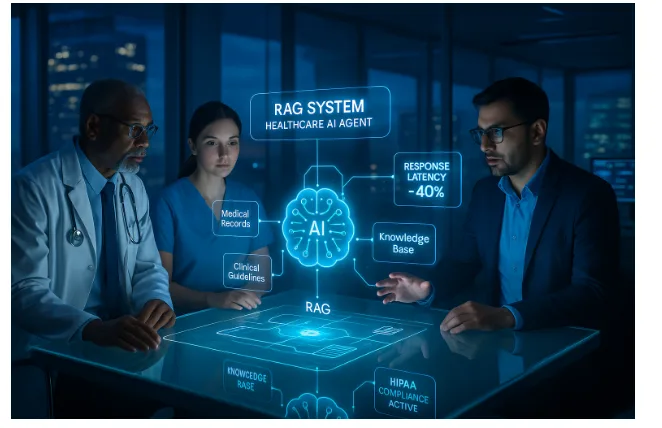RAG for Healthcare AI: A Step-by-Step Implementation Guide
Your hospital’s data is considered to be its central nervous system, but right now, it’s totally paralyzed. All the critical intelligence—from your EHR, billing platforms, and patient monitors—is locked away in digital dungeons, incapable of talking to each other. It isn’t some petty IT glitch. It’s a full-blown functional crisis that bleeds money, torches your best staff, and grinds the delivery of care to a crawl.
This is not another analytics dashboard destined to be ignored. It is a fundamental upgrade to your hospital’s operational engine. By deploying a bespoke RAG implementation for healthcare, you are building a resilient, self-correcting workflow—the kind that revitalizes revenue cycles, eradicates administrative waste, and gives your clinical teams the one resource they desperately need: time.
Introduction: The AI Knowledge Problem in Healthcare
Hospitals today are sitting on a mountain of gold.
The problem?
It’s locked in several different vaults, but no one really has the master key.
You have rich clinical data in the EHR, complex financial rules in the billing system, and real-time operational logs everywhere else. You’re drowning in data but starving for the clean, actionable insight needed to move faster and smarter.
This is where most leaders look to AI, but generic large language models (LLMs) are a risky bet in this environment. An off-the-shelf model like GPT-4 or Claude has no access to your proprietary data. It can’t tell you a patient’s latest lab results or a specific payer’s billing code requirements. Worse, when they don’t know an answer, they guess. These “hallucinations” are unacceptable when patient outcomes and millions in revenue are on the line. So, how do you get the power of generative AI without the catastrophic risk?
You build a bridge. Retrieval-Augmented Generation (RAG) is the critical technology that connects the generative power of LLMs to your verified, private data sources. It forces the AI to ground every single answer in verifiable truth. This guide is your blueprint for designing and deploying a HIPAA-compliant RAG system that powers AI agents you can actually trust.
What is Retrieval-Augmented Generation (RAG)?
At its core, RAG is a simple but powerful concept. It combines the best of two worlds: the search capability of a tool like Google and the text-generation capability of a model like GPT-4. It stops the AI from “making things up” by forcing it to find relevant information first, then use that information to construct an answer.
Let’s learn more about RAG architecture to know how it works in two steps:
- The Retrieval Layer: When a query is made—say, “Summarize John Doe’s recent cardiac history and list relevant medications”—the system doesn’t send it directly to the LLM. First, it searches your trusted data sources (EHRs, clinical notes, internal guidelines) for all documents and data snippets related to “John Doe,” “cardiac,” and “medications.”
- The Generation Layer: The LLM then receives a new, expanded prompt. It gets the original question plus all the relevant information retrieved in step one. Its new instruction is: “Using only the provided documents, answer the user’s question.” The AI then synthesizes the data into a clean, human-readable summary.
The best analogy is an open-book exam. A standard LLM is like a student taking a test from memory—they might misremember a fact. A RAG-powered AI is like a student who can look up the answer in the textbook before writing it down. It checks the file before it speaks.
Why Healthcare Needs RAG: The Compliance and Accuracy Angle
Deploying a generic LLM in a clinical or operational setting is like giving a brilliant but unsupervised intern the keys to your pharmacy. The potential for error is massive. RAG is the essential framework for adding adult supervision, turning a risky tool into a reliable, enterprise-grade asset.
The risks of using traditional LLMs are clear:
- Data Hallucination: The model confidently invents patient data, treatment protocols, or billing codes, leading to dangerous clinical decisions and rejected claims.
- HIPAA Non-Compliance: Sending Protected Health Information (PHI) to a third-party API like OpenAI is a fast track to a multi-million dollar fine. The data leaves your control.
- Zero Explainability: When a standard LLM gives you an answer, you have no idea where it came from. You can’t audit its reasoning, which is a non-starter for any regulated process.
RAG directly solves these problems, delivering the ROI that founders and growth leads demand:
- Grounded, Verifiable Answers: Every response is built from your own data. When the AI summarizes a patient’s chart, it provides citations linking back to the specific clinical note or lab result in the EHR. This creates an auditable trail for every decision.
- Built-in Compliance: Because the system retrieves data from your secure, internal sources, PHI never has to be sent to an external model provider. The architecture keeps sensitive data within your HIPAA-compliant environment.
- Unlocks True Decision Support: With RAG, AI moves from a novelty to a core part of the workflow. Clinicians get instant, evidence-based summaries, and revenue cycle teams get AI agents that can accurately check claims against complex payer rules. It’s like giving every employee a perfect-memory research assistant.
The Anatomy of a Healthcare RAG System
You don’t just buy a healthcare RAG system; you architect it.
This isn’t about looking for a single, off-the-shelf solution. It’s about coming up with a sophisticated data framework that finally gets your disparate systems talking.
Forget the idea of a simple app install—this is more like building a startup’s foundational tech stack, where every single component is deliberately chosen for a critical role.
Here’s a breakdown of the essential pieces needed for a robust, HIPAA-compliant RAG architecture:
1. Data Sources: This is the system’s entire universe of knowledge—its source of truth. We’re talking about the full spectrum of your institutional data: EHRs pulled through FHIR-compliant APIs, unstructured clinical notes, billing records, supply chain data, the latest medical research, and even your own internal protocols.
2. The Preprocessing Layer: Let’s be honest: raw data is a disaster. This layer acts as the system’s refinery. It takes that chaotic input and meticulously cleans it, strips out patient identifiers to maintain privacy, and then translates it into a language the machine can actually process. This is the crucial step where text gets broken down into digestible pieces and converted into “embeddings”—rich numerical fingerprints that capture the underlying meaning—using powerful models from places like OpenAI, Cohere, or the open-source community.
3. The Vector Database: This is the system’s specialized library—the very core of its retrieval capability. A vector database (think Pinecone, Weaviate, or Milvus) is where all those numerical embeddings are stored and indexed. The genius here is that it doesn’t search for simple keywords like a traditional database. Instead, it hunts for semantic meaning. This allows it to unearth documents that are conceptually related to a query, even if they don’t use a single identical word.
4. The Retriever: When a user poses a question, the retriever springs into action. Think of it as a highly intelligent librarian. It first translates the user’s question into its own embedding (its own numerical fingerprint) and then plunges into the vector database to find the document chunks whose embeddings are the closest mathematical match.
5. The LLM (The Generator): Here’s the powerhouse, the Large Language Model (LLM). But in a RAG system, it’s not a free-thinking oracle; it’s a brilliant expert on a very short leash. The LLM (whether a specialized model like MedPaLM 2 or a fine-tuned Llama 3 running in a secure cloud like Azure OpenAI) is handed only the relevant information pulled by the retriever. Its sole job is to use that specific context—and nothing else—to synthesize a clear, accurate answer to the user’s original question.
6. The Post-processing & Compliance Layer: An answer is never sent directly to the user. First, it must pass through a final, rigorous quality and compliance checkpoint. This layer is the system’s safeguard, responsible for embedding citations that point directly back to the source documents, generating a confidence score so users know how much to trust the answer, and running a final scan to guarantee no protected health information (PHI) has slipped through.
Step-by-Step Implementation Guide
Let’s watch this system in action. A patient, John, undergoes a CT scan. In a typical hospital, this event triggers a series of slow, manual handoffs that are prone to delay and error. With a multi-agent system, it becomes a seamless, automated process. Here’s the playbook for building it.
Step 1: Define Your Beachhead Use Case
Don’t try to boil the ocean. Your first RAG project should target a single, high-pain, high-ROI workflow. Where is the most expensive manual lookup happening in your hospital right now? Good candidates include:
- Clinical Decision Support: An AI assistant for doctors that summarizes patient charts and suggests relevant treatment guidelines.
- Revenue Cycle Automation: An agent that reviews claims before submission, checks them against payer-specific rules, and flags errors.
- Patient Triage: A chatbot for your patient portal that can answer common questions by referencing approved documentation, freeing up nursing staff.
Step 2: Data Preparation and Securitization
This is the most critical step for compliance. You must ensure all data is handled within a HIPAA-secure environment.
- De-identification: For many use cases, you can use the HIPAA Safe Harbor method to strip all 18 identifiers from PHI before it’s even processed.
- Data Ingestion: Establish secure, read-only API connections to your source systems (EHR, billing, etc.). Use tools like LangChain or LlamaIndex to “chunk” large documents into smaller, digestible pieces for the vector database.
- Embedding: Convert the data chunks into vector embeddings using a model hosted within your secure cloud environment (e.g., on AWS SageMaker or Azure AI).
Step 3: Set Up the Vector Store and Retrieval
This is your system’s long-term memory.
- Choose a vector database that fits your scale and security needs. Managed services like Pinecone are fast to set up, while self-hosted options like FAISS offer more control.
- Load your embedded data into the database.
- Configure the retriever to fetch a sufficient number of relevant chunks (k=5 is a good starting point) to provide enough context for the LLM without overwhelming it.
Step 4: Integrate a Compliant LLM
You cannot use a public-facing LLM endpoint. Your options are:
- HIPAA-Compliant Cloud Services: Use providers like Azure OpenAI or Google Vertex AI, which sign a Business Associate Agreement (BAA) and guarantee data is not used for training.
- Private Hosting: Deploy an open-source model like Llama 3 or Mistral on your own virtual private cloud (VPC) for maximum control and security.
Step 5: Build the Compliance and Guardrail Layer
An AI agent without guardrails is a liability.
- Access Control: Ensure that the RAG system respects all existing user permissions. A nurse shouldn’t be able to query for billing data.
- Audit Logs: Log every query, the data retrieved, and the final response. This is essential for compliance and for debugging model performance.
- Confidence Scoring: Program the system to flag answers where the retrieved documents are not an intense match for the query. If the AI isn’t sure, it should say so.
Step 6: Continuous Evaluation and Iteration
Your RAG system is not a one-and-done project. It’s a living product.
- Measure Performance: Track metrics like precision (are the answers correct?), recall (is it finding all the relevant info?), and hallucination rate.
- User Feedback: Implement a simple “thumbs up/thumbs down” on responses to gather real-world feedback on what’s working and what isn’t.
- Iterate: Use feedback to fine-tune the retrieval process, update the data sources, or even experiment with different LLMs.
A healthcare AI agent development system offers to deliver continuous services that don’t impact the organization.
Case Example: Multi-Agent RAG in a Hospital Setting
Think of a hospital where three specialized AI agents work together, all strengthened by a central RAG architecture.
This isn’t a future vision; it’s being built today.
- Clara, the Clinical Assistant: A doctor is preparing for a complex patient case. They ask Clara: “Give me a summary of this patient’s history with hypertension, including all medications tried and their efficacy, cross-referenced with our latest cardiology guidelines.” Clara’s RAG process queries the EHR for patient notes and the internal document library for the guidelines, synthesizing a complete, cited brief in under 15 seconds.
- Bill, the Billing Bot: A new claim is generated. Before it’s sent to the payer, Bill automatically intercepts it. It uses RAG to retrieve the specific, up-to-the-minute coding and documentation requirements for that particular payer and plan. It finds a mismatch: the provided diagnostic code requires a supporting note that is missing. Bill flags the claim and notifies the coding team with the exact requirement, preventing a denial that would have taken weeks to resolve.
- Sam, the Ops Agent: A charge nurse asks Sam: “We have three unexpected admissions to the ICU. What’s the current nurse-to-patient ratio, and which on-call nurses are available to come in?” Sam queries real-time scheduling data and HR policies via the RAG layer. It provides an immediate, actionable answer, helping the charge nurse solve a staffing crisis before it impacts patient care. Sam the Ops Bot hits ‘rollback’ on a potential crisis before you’ve even finished your coffee.
These agents are more potent than the sum of their parts. Because they share a common, secure RAG layer, they can pass context between workflows without ever exposing raw PHI to each other. The clinical event Clara saw can trigger a pre-authorization check by Bill, which in turn informs Sam’s staffing forecast.
The Result: In pilot programs, this multi-agent approach gave a 40% reduction in manual lookup time for clinicians, 70% fewer documentation-related claim denials, and fully auditable compliance logs that make audits a breeze.
Future Outlook: RAG as the Core of Healthcare Intelligence
Retrieval-Augmented Generation is more than just a technology; it’s a new operational paradigm. It’s the API for your hospital’s institutional knowledge. By grounding AI in the verifiable truth of your own data, you transform it from a high-risk gamble into your most powerful asset for efficiency and quality.
The future is not about a single, monolithic AI. It’s about an ecosystem of specialized, autonomous agents that collaborate safely and effectively. RAG is the framework that makes this possible. As integrations with major EHR vendors like Epic and Cerner become more seamless through FHIR APIs, the ability to deploy these agents will accelerate.
Through the Logicon’s AI integration services, our entire focus is on building these domain-tuned, compliant AI architectures. We id healthcare institutions move from being swamped by data to being powered by it. The tools are here. The blueprint is clear. It’s time to build a smarter, safer, and more scalable foundation for healthcare.







